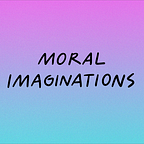The future can be one of hope, not fear
Imagining our way from good to great — by Ian Gilson
This blog is part of a series of blogs written by the participants of the Camden Imagines programme. This eight week training introduced council officers and public servants to the skills of collective imagination and horizontal leadership to empower them to become agents of change in the borough.
Ian is an Organisational Design Lead. Ian’s team work across Camden, to address the systemic issues that help us thrive in our jobs.
What could we do today that will unleash the imagination of our teams?
As you go through your working life, there are people you meet, conversations you hear and words you read, that inspire and change your thinking. Working with Phoebe Tickell this past year has certainly added to my list and reflecting on her Moral Imaginations approach has led me to make some links with that library in my head.
Around a decade ago, I was introduced to the Stockdale Paradox from Jim Collins’ book, Good To Great. Admiral Jim Stockdale was the highest ranking US prisoner of war in Vietnam and was one of the few who survived their captivity. He spent 8 years without any prisoner rights, repeatedly tortured, with no set release date, and no certainty as to whether he would survive to see his family again.
Stockdale survived by balancing two, conflicting perspectives. Firstly, he never lost faith in the end of his story, carrying an unwavering belief that he would prevail in the end. Set against that, he had the discipline to confront the most brutal facts of his current reality, whatever they were. In his experience, it was dangerous to lose hope, but equally as dangerous to be over-optimistic. When “We’ll be out by Christmas” turns into “we’ll be out by Easter” and that rotates on to Christmas again, it breaks the heart and the resolve.
In the office we struggle with both long term hope and short term realism. We hide failures instead of learning from them and we are so bogged down with managing today, we can’t raise our heads high enough to focus on the future. How might we balance long term hope with short term realism and crack the Stockdale Paradox?
It struck me that Moral Imaginations’ Imagination Activism programme could help break the paradox by offering a different kind of activism. Our programme with Phoebe encouraged psychological safety to share our vulnerabilities, celebrate our failures and learn from them. Crucially, it also proposed a razor-sharp focus on hope for the future. It pushed back the horizon of our thinking — imagining what great would look like from the perspective of our future generations. People whose names we will never know, but whose lives are heavily reliant on the decisions we make now.
What if we held future generations as stakeholders in our key decisions? How might we ensure their voices are heard in our meetings when we make those decisions?
If that were to happen, then how might our decisions be different? Our political and investment cycles are rooted in the short-term. KPIs measure this quarter versus last, this year versus last. It is difficult to think 3–5 years ahead, let alone 30, 50, 100, 200!
But the big decisions we make now will have profound effects for the generations ahead. Where and how we build our homes, how we pay for the NHS and our pensions, how we pay for social care. How we make life on Earth sustainable. The choices we make now will shape the issues for the generations that follow us. Collectively, we can chip away at these macro problems through the micro decisions we make every day.
Phoebe gave us the idea that collective imagination combined with collective responsibility to what’s truly important is more than enough to find solutions and ideas that work — the future can be one of hope, not fear. One problem is that too many of us are held back from using our imagination and creativity is stifled.
I feel this emerges as two particular issues in the workplace;
1. Inequity of who gets to be creative
In my experience, many of the best ideas come from those who work closest to our citizens and customers, but they are least likely to have the opportunity to join the creative spaces we have. To make the best decisions, we need to unleash that creativity, by allowing everyone to flex their imaginative muscle, not just the lucky few.
2. Attitude to risk
The pressure for quick fixes and ‘single-loop’ solutions is often overwhelming. To mitigate risk we end up tinkering with the old ways, rather than being bold and imagining the new. If we were to extend the horizon of our thoughts and have the belief that what we do now can positively impact our future friends and families, we can find better, ‘double-loop’ solutions that balance our needs with theirs.
As leaders and managers it’s our role to be clear on vision and purpose. However, it’s also our role to step back and create great spaces for our teams to bring ideas forward and provide the best chance to make them work. Our role is to unblock whatever gets in the way of purposeful creativity and help it flourish. In Phoebe’s terms, that means us being less ‘yes, but’ and more ‘yes, and…’
What could we do today that will unleash the imagination of our teams?
This blog is part of a series written by Camden’s Imagination Activists as part of their Imagination Activism programme called “Camden Imagines”. To read the other blogposts in the series, please visit this link.
